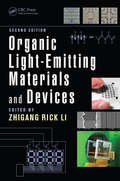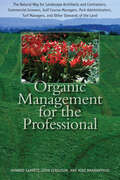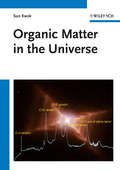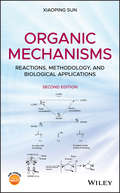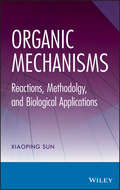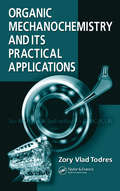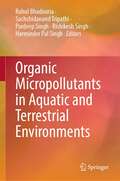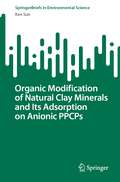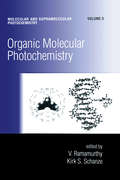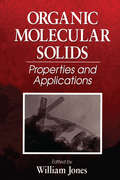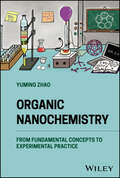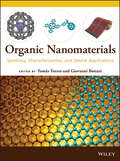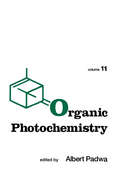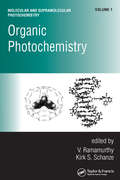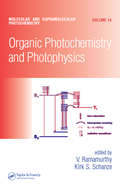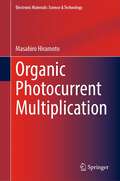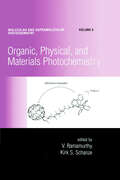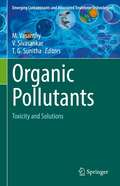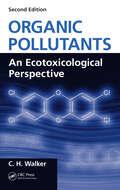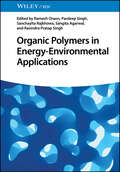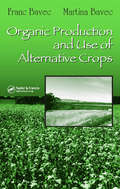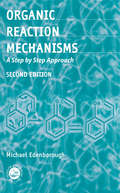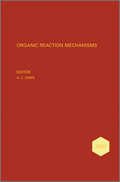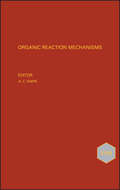- Table View
- List View
Organic Light-Emitting Materials and Devices
by Zhigang Rick LiOrganic Light-Emitting Materials and Devices provides a single source of information covering all aspects of OLEDs, including the systematic investigation of organic light-emitting materials, device physics and engineering, and manufacturing and performance measurement techniques. This Second Edition is a compilation of the advances made in recent years and of the challenges facing the future development of OLED technology. <P><P>Featuring chapters authored by internationally recognized academic and industrial experts, this authoritative text: <P><P> Introduces the history, fundamental physics, and potential applications of OLEDs Reviews the synthesis, properties, and device performance of electroluminescent materials used in OLEDs Reflects the current state of molecular design, exemplifying more than 600 light-emitting polymers and highlighting the most efficient materials and devices Explores small molecules-based OLEDs, detailing hole- and electron-injection and electron-transport materials, electron- and hole-blocking materials, sensitizers, and fluorescent and phosphorescent light-emitting materials Describes solution-processable phosphorescent polymer LEDs, energy transfer processes, polarized OLEDs, anode materials, and vapor deposition manufacturing techniques employed in OLED fabrication Discusses flexible display, the backplane circuit technology for organic light-emitting displays, and the latest microstructural characterization and performance measurement techniques Contains abundant diagrams, device configurations, and molecular structures clearly illutrating the presented ideas <P><P> Organic Light-Emitting Materials and Devices, Second Edition offers a comprehensive overview of the OLED field and can serve as a primary reference for those needing additional information in any particular subarea of organic electroluminescence. This book should attract the attention of materials scientists, synthetic chemists, solid-state physicists, and electronic device engineers, as well as industrial managers and patent lawyers engaged in OLED-related business areas.
Organic Management for the Professional: The Natural Way for Landscape Architects and Contractors, Commercial Growers, Golf Course Managers, Park Administrators, Turf Managers, and Other Stewards of the Land
by Howard Garrett John Ferguson Mike AmaranthusA handbook for organic landscaping and turf management for recreational and commercial properties, public spaces, parks and urban gardens. Can you manage the landscape of a golf course, city park, or corporate campus without synthetic fertilizers and toxic pesticides? Absolutely! Organic landscaping is not only possible on a large scale, but it also makes sense both economically and environmentally. It promotes healthy soils and plants, which require less water and sequester more carbon—a winning combination for both your bottom line and the planet&’s fight against resource depletion and global warming. Organic programs on a commercial scale have enormous potential to make a difference in the quality of our environment, our use of fuels, and climate change. And as those who have already converted to organics have discovered, they also cost a lot less over the long term. Organic Management for the Professional is the first comprehensive guide to &“going green&” in large-scale landscaping. Nationally recognized organic gardening expert Howard Garrett, with associates John Ferguson and Mike Amaranthus, not only explains in detail how to manage projects with natural organic techniques, but also presents the material in clear, simple terms so that commercial and institutional property owners can understand what to ask of their landscape architects, contractors, growers, and maintenance people. They give detailed, proven instructions for the key components of organic landscaping—soil building, correct planting techniques, fertilizing, pest control, compost, and mulch. Then they show how to apply these organic methods in large-scale landscaping, commercial growing, such as orchards, tree farms, nurseries, and greenhouse operations, and recreational properties such as sports fields and parks.
Organic Matter in the Universe
by Sun KwokAuthored by an experienced writer and a well-known researcher of stellar evolution, interstellar matter and spectroscopy, this unique treatise on the formation and observation of organic compounds in space includes a spectroscopy refresher, as well as links to geological findings and finishes with the outlook for future astronomical facilities and solar system exploration missions. A whole section on laboratory simulations includes the Miller-Urey experiment and the ultraviolet photolysis of ices.
Organic Mechanisms: Reactions, Methodology, and Biological Applications
by Xiaoping SunThis book helps readers move from fundamental organic chemistry principles to a deeper understanding of reaction mechanisms. It directly relates sophisticated mechanistic theories to synthetic and biological applications and is a practical, student-friendly textbook. Presents material in a student-friendly way by beginning each chapter with a brief review of basic organic chemistry, followed by in-depth discussion of certain mechanisms Includes end-of-chapter questions in the book and offers an online solutions manual along with PowerPoint lecture slides for adopting instructors Adds more examples of biological applications appealing to the fundamental organic mechanisms Presents material in a student-friendly way by beginning each chapter with a brief review of basic organic chemistry, followed by in-depth discussion of certain mechanisms Includes end-of-chapter questions in the book and offers an online solutions manual along with PowerPoint lecture slides for adopting instructors Adds more examples of biological applications appealing to the fundamental organic mechanisms
Organic Mechanisms
by Xiaoping SunInstills a deeper understanding of how and why organic reactions happenIntegrating reaction mechanisms, synthetic methodology, and biological applications, Organic Mechanisms gives organic chemists the tools needed to perform seamless organic reactions. By explaining the underlying mechanisms of organic reactions, author Xiaoping Sun makes it possible for readers to gain a deeper understanding of not only chemical phenomena, but also the ability to develop new synthetic methods. Moreover, by emphasizing biological applications, this book enables readers to master both advanced organic chemistry theory and practice.Organic Mechanisms consists of ten chapters, beginning with a review of fundamental physicochemical principles that are essential for understanding the nature of organic mechanisms. Each one of the remaining chapters is devoted to a major class of organic reactions, including:Aliphatic C-H bond functionalizationFunctionalization of the alkene C=C bond by cycloaddition reactionsNucleophilic substitutions on sp3-hybridized carbonsNucleophilic additions and substitutions on carbonyl groupsReactivity of the α-hydrogen to carbonyl groupsRearrangementsA brief review of basic organic chemistry begins each chapter, helping readers move from fundamental concepts to an advanced understanding of reaction mechanisms. Key mechanisms are illustrated by expertly drawn figures highlighting microscopic details. End-of-chapter problems enable readers to put their newfound knowledge into practice by solving key problems in organic reactions with the use of mechanistic studies, and a Solutions Manual is available online for course instructors.Thoroughly referenced and current with recent findings in organic reaction mechanisms, Organic Mechanisms is recommended for upper-level undergraduates and graduate students in advanced organic chemistry, as well as for practicing chemists who want to further explore the mechanistic aspects of organic reactions.
Organic Mechanochemistry and Its Practical Applications
by Zory Vlad TodresOrganic Mechanochemistry and Its Practical Applications gathers physical and organic chemistry-based molecular principles, evolving interpretations of scientific data, and real world applications to demonstrate the synthetic advantages of mechanically initiated organic reactions. This book considers transformations of organic substances upon
Organic Micropollutants in Aquatic and Terrestrial Environments
by Rahul Bhadouria Sachchidanand Tripathi Pardeep Singh Rishikesh Singh Harminder Pal SinghThis book offers a comprehensive overview of the origins, occurrences, and remediation strategies for organic micropollutants in the environment. Divided into five parts, the book starts with a perspective on the sources and prevalence of organic micropollutants in our world, including aquatic ecosystems and urban soils, followed by an examination of the effects of these contaminants on health, agriculture, and the environment. In the third and fourth parts of the book, readers will learn more about the analysis and detection of organic micropollutants, and treatment and remediation strategies, respectively. The book closes with an overview of policies and regulatory measures, and critiques the fate of organic micropollutants in the aquatic environment. In this book, particular attention is given to topics such as: the intricate relationship between micropollutants, the environment, and human healthsustainable management, treatment methodsand remediation for micropollutants in wastewater, urban water systems, freshwaters, urban soils, and agricultureecotoxicity analysis and innovative bioremediation approachesReaders will also find a valuable discussion of the current contamination status of aquatic ecosystems by pharmaceutical and personal care micropollutants, the latest methodologies for analysing organic micropollutants, and a case study on the biodegradation pathways of hexachlorocyclohexane (HCH). Given its breadth, this book is a useful resource for scientists, researchers, policymakers, and anyone concerned about the ecological and human health impacts of organic micropollutants.
Organic Modification of Natural Clay Minerals and Its Adsorption on Anionic PPCPs (SpringerBriefs in Environmental Science)
by Ken SunThis book mainly investigates the adsorption of anionic diclofenac sodium on natural clay minerals, the adsorption of anionic chloramphenicol on natural clay minerals and the behavior of surface and interface modification or adsorption on clay minerals. It has significant guidance for learning the transfer and fate of pharmaceuticals and personal care products (PPCPs) in the soil. It develops an efficient, low-cost adsorbent material and provides theoretical basis and valuable reference for the effective prevention of groundwater contamination of PPCPs in the field of environmental engineering.
Organic Molecular Photochemistry (Molecular And Supramolecular Photochemistry Ser. #3)
by V. Ramamurthy Kirk S. SchanzeFocuses on complex naturally occurring and synthetic supramolecular arrays. The text describes applications of photochemistry in cystalline organic matrices; covers two-component crystals - crystalline molecular compounds, mixed crystals and simple mechanical mixtures - in solid and liquid phases; assesses photoinduced fragmentation of carbon-heteroatom bonds; and more.
Organic Molecular Solids: Properties and Applications
by William JonesInterest in organic molecular solids extends to a range of fields including chemistry, physics, electrical engineering, and materials science. In chemistry, it applies to such topics as solid state reactivity, crystal engineering, theoretical approaches to crystal structure determination, and morphology control. In physics, electrical engineering, and materials science, the possibility of producing organic-based materials (such as crystals, polymers, thin films, or liquid crystals) with potential electronic, opto-electronic, and magnetic uses is a major area of current research interest throughout the world. Organic Molecular Solids examines the uses of organic-based materials over a wide range of applications and interests. Each chapter surveys a relevant topic, providing appropriate introductory background information and modern developments.
Organic Nanochemistry: From Fundamental Concepts to Experimental Practice
by Yuming ZhaoORGANIC NANOCHEMISTRY How-to guide for entry-level practitioners to quickly learn the cutting-edge research concepts and methodologies of modern organic nanochemistry Organic Nanochemistry describes the fundamentals of organic nanochemistry research, encompassing modern synthetic reactions, supramolecular strategies, nanostructure and property characterization techniques, and state-of-the-art data analysis and processing methods, along with synthetic chemistry as applied to organic nanomaterials and molecular devices. Accompanying each of these principles are case studies (from basic design to detailed experimental implementation) to help the reader fully comprehend the concepts and methods involved. Various theories suitable for nanoscale simulations, including quantum mechanics, semi-empirical quantum mechanics, and molecular dynamics theories, are discussed at an introductory level. Computational examples are provided, allowing interested readers to grasp essential modelling techniques for better understanding of organic nanochemistry. The content is paired with online supplementary material that includes instructional materials and guides to using common scientific software for computational modelling and simulations. Written by a highly qualified professor, Organic Nanochemistry includes discussion on: Key concepts and theories of organic chemistry, which are essential to understand the fundamental properties of organic molecular and supramolecular systems Useful synthetic methodologies for the synthesis and functionalization of organic nanomaterials, and the chemistry and application of exotic carbon nanomaterials Supramolecular aspects in organic nanochemistry, especially the well-developed disciplines of host-guest chemistry and organic self-assembly chemistry Construction and testing of molecular devices and molecular machines and state-of-the-art computational modelling methods for properties of nanoscale organic systems Guiding the reader on a journey from familiar chemical concepts and principles to cutting-edge research of nano-science and technology, Organic Nanochemistry serves as an excellent textbook learning resource for advanced and graduate students, as well as a self-study guide or how-to reference for practicing chemists.
Organic Nanomaterials: Synthesis, Characterization, and Device Applications
by Tomas Torres Giovanni BottariDiscover a new generation of organic nanomaterials and their applications Recent developments in nanoscience and nanotechnology have given rise to a new generation of functional organic nanomaterials with controlled morphology and well-defined properties, which enable a broad range of useful applications. This book explores some of the most important of these organic nanomaterials, describing how they are synthesized and characterized. Moreover, the book explains how researchers have incorporated organic nanomaterials into devices for real-world applications. Featuring contributions from an international team of leading nanoscientists, Organic Nanomaterials is divided into five parts: Part One introduces the fundamentals of nanomaterials and self-assembled nanostructures Part Two examines carbon nanostructures—from fullerenes to carbon nanotubes to graphene—reporting on properties, theoretical studies, and applications Part Three investigates key aspects of some inorganic materials, self-assembled monolayers, organic field effect transistors, and molecular self-assembly at solid surfaces Part Four explores topics that involve both biological aspects and nanomaterials such as biofunctionalized surfaces Part Five offers detailed examples of how organic nanomaterials enhance sensors and molecular photovoltaics Most of the chapters end with a summary highlighting the key points. References at the end of each chapter guide readers to the growing body of original research reports and reviews in the field. Reflecting the interdisciplinary nature of organic nanomaterials, this book is recommended for researchers in chemistry, physics, materials science, polymer science, and chemical and materials engineering. All readers will learn the principles of synthesizing and characterizing new organic nanomaterials in order to support a broad range of exciting new applications.
Organic Photochemistry (Organic Photochemistry Ser. #11)
by Albert PadwaOrganic photochemistry is the science arising from the application of photochemicalmethods to organic chemistry and organic chemical methods to photochemistry. It is aninterdisciplinary frontier.Intense activity in organic photochemistry in the last decade has produced so vast anaccumulation of factual knowledge that chemists in general have viewed it with awe.Even those chemists engaged in the study of organic photochemistry will find the rate ofdevelopment in the field perplexing to a high degree. This series originated to fill theneed for a critical summary of this vigorously expanding field with the purpose ofdrawing together seemingly unrelated facts, summarizing progress, and clarifyingproblems.Volume 11 continues to fulfill the original, essential role of this unique series byproviding a convenient review of the structural aspects of organic photochemistry. Aswith earlier volumes, this new book offers the research findings of distinguishedauthorities. It stresses timely aspects of organic photochemistry-previously scatteredthroughout the large body of literature-for which necessary critical review has beenlacking.This volume of the series emphasizes the mechanistic details of the di-n:-methanerearrangement . .. the synthetic aspects of the oxadi-n:-methane reaction ... thephotochemistry of carbenium ions and related species .. . photoinduced hydrogen atomabstraction by carbonyl compounds ... and matrix photochemistry of nitrenes, carbenes,and excited triplet states. Complete with numerous illustrations and bibliographiccitations of the literature, this book explores these important processes to the advantageof organic chemists, as an aid to research and as a source for supplementary knowledgeon particular topics .
Organic Photochemistry
by V. RamamurthyFeatures surveys of all areas of organic, inorganic, physical and biological photochemistry. The text serves as a source of scientific findings pertinent to chemistry and biochemistry. It addresses the state of developments in the field, employing reviews of active research, including recent innovations, techniques and applications.
Organic Photochemistry and Photophysics (Molecular And Supramolecular Photochemistry Ser. #Vol. 14)
by V. Ramamurthy Kirk S. SchanzeFeaturing contributions from leading experts, Organic Photochemistry and Photophysics is a unique resource that addresses the organic photochemistry and photophysical behavior in aromatic molecules, thiocarbonyls, selected porphyrins, and metalloporphyrins.The book presents theories pertaining to radiative and radiationless transitions. It
Organic Photocurrent Multiplication (Electronic Materials: Science & Technology)
by Masahiro HiramotoThis book opens the eyes of readers to the clear relationship between the molecular-sized structures and the macroscopic functions of organic devices. The discovery of novel phenomena and the mechanism of multiplied photocurrent generation in organic semiconductors, which can be applicable to amplification-type photosensors, are concisely summarized. The motivation for writing this book is to let readers know how the novel phenomena were discovered and how the novel concepts were created. The main features here include the discovery of photocurrent multiplication, the tunneling mechanism, the structural trap model, novel phenomena related to photocurrent multiplication, avalanche multiplication, and ideas for the future. This book is of interest to new and experienced scientists as well as graduate students. The author strongly hopes that the young scientists of the next generation will be enthusiastically inspired by this book and will develop the field of organic semiconductors even further.
Organic Photoreceptors for Imaging Systems (Optical Science and Engineering)
by Paul M. Borsenberger David S. WeissThis reference covers in detail the preparation and application of current and emerging organic materials used as xerographic photoreceptors, emphasizing the photo-electric properties of organic solids and evaluating their potential use in xerography.;Reviewing the development of xerography and the steps in the xerographic process, this volume: summarizes the properties, advantages and disadvantages of various classes of materials used as photoreceptors; describes the methods of characterizing the sensitometry of xerographic photoreceptors; examines the physics and chemistry of photogeneration and charge transport processes; and elucidates the sensimetry of different classes of organic materials.;Organic Photoreceptors for Imaging Systems is intended for imaging scientists, optical engineers and physicists, organic chemists, materials scienctists and students in these disciplines.
Organic, Physical, and Materials Photochemistry
by Kirk S. SchanzeThis text examines organic, physical and materials photochemistry. It reports the first example of a TiO2 sensitization with a fullerene-based donor-acceptor dyad, and covers halophenols, diflusinal photochemistry, hydroxystyrenes, acetylenes, and other related compounds. The volume also investigates whether c,d-alkenes influence the efficiency and
Organic Pollutants: Toxicity and Solutions (Emerging Contaminants and Associated Treatment Technologies)
by M. Vasanthy V. Sivasankar T. G. SunithaThis volume describes the identification of emerging organic pollutants, mainly from industrial sources, their associated toxicological threats, and the latest green methods and biotechnological solutions to abate harmful impacts on people and the environment. The chapters present reviews on current applied toxicology research, occupational health hazards and green remedial solutions for pollution control in terrestrial and aquatic environments, with the aim of raising public awareness of these issues and providing chemists, toxicologists and environmental scientists with the knowledge to combat organic pollutants through sustainable means. Readers will learn about the multi-dimensional applications of materials and processes which harvest energy out of environmental remediation technologies, as well as the roles of biotechnology and nanotechnology in addressing high pollutant load. Specific attention is paid to technologies that draw energy through wastewater remediation, as this covers the primary means by which organic pollutants are introduced into the environment from industry and other sources. The book will be of use to pollution control boards, industry regulators, and students and researchers in the fields of biotechnology, biomedical science, hydrology and water chemistry.
Organic Pollutants: An Ecotoxicological Perspective, Second Edition
by C. H. WalkerDifficult to measure accurately and deal with effectively, organic pollutants continue to be a major hazard in the environment. Significantly expanded, the second edition of Organic Pollutants: An Ecotoxicological Perspective describes the mechanistic basis of ecotoxicology, using major groups of pollutants as illustrative examples, and explores th
Organic Polymers in Energy-Environmental Applications
by Ramesh OraonEnables readers to understand core concepts behind organic polymers and their multifunctional applications, focusing on environmental and sustainable applications Organic Polymers in Energy-Environmental Applications provides comprehensive coverage of polymerization and functionalization of organic polymers, followed by innovative approaches, sustainable technologies, and solutions for energy and environmental applications, including environmental remediation, energy storage, corrosion protection, and more. Edited by five highly qualified academics with significant experience in the field, Organic Polymers in Energy-Environmental Applications includes discussion on: Characteristics and emerging trends of organic polymers, and organic polymers in imaging industries and curable coatingsAntifouling technology based on organic polymers and wearable technology featuring multifunctional sensor arrays in biomedicineOrganic bio-adhesive polymers in filter technology, nano-architectured organic polymers, and market dynamics of organic polymer-based technologiesOrganic and inorganic modifications of polymers, pollutant removal via organic polymers, and biodegradable organic polymersLife cycle assessment of organic polymers, applications of organic polymers in agriculture, and future outlooks of the field With complete coverage of organic polymers, a topic of high interest due to their numerous practical applications ranging from membranes to super capacitors, Organic Polymers in Energy-Environmental Applications is an essential resource for polymer and environmental chemists, materials scientists, and all other related researchers and professionals interested in the subject.
Organic Production and Use of Alternative Crops (Books In Soils, Plants, And The Environment Ser. #Vol. 115)
by Franc Bavec Martina BavecMerging coverage of two increasingly popular and quickly growing food trends, Organic Production and Use of Alternative Crops provides an overview of the basic principles of organic agriculture and highlights its multifunctionality with special emphasis on the conservation of rare crops and their uses. Considering more than 30 disregarded and negle
Organic Reaction Mechanisms: A Step by Step Approach (Second Edition)
by Michael EdenboroughThis text is designed to teach students how to write organic reaction mechanisms. It starts from the absolute basics - counting the numbers of electrons around a simple atom. Then, in small steps, the text progresses to advanced mechanisms. the end, all the major mechanistic routes have been covered. The text is in the form of interactive sections, which are designed to facilitate the assimilation of the information conveyed, so that by the end the student should already know the contents without the need for extensive revision.
Organic Reaction Mechanisms 2007: An annual survey covering the literature dated January to December 2007 (Organic Reaction Mechanisms Series #138)
by A. C. KnipeOrganic Reaction Mechanisms 2007, the 43rd annual volume in this highly successful and unique series, surveys research on organic reaction mechanisms described in the available literature dated 2007. The following classes of organic reaction mechanisms are comprehensively reviewed: Reaction of Aldehydes and Ketones and their Derivatives Reactions of Carboxylic, Phosphoric, and Sulfonic Acids and their Derivatives Oxidation and Reduction Carbenes and Nitrenes Nucleophilic Aromatic Substitution Electrophilic Aromatic Substitution Carbocations Nucleophilic Aliphatic Substitution Carbanions and Electrophilic Aliphatic Substitution Elimination Reactions Polar Addition Reactions Cycloaddition Reactions Molecular Rearrangements An experienced team of authors compile these reviews every year, so that the reader can rely on a continuing quality of selection and presentation.
Organic Reaction Mechanisms 2008: An annual survey covering the literature dated January to December 2008 (Organic Reaction Mechanisms Series #137)
by A. C. KnipeThis volume is the 44th in this classical series. In every volume relevant reaction mechanisms are featured in chapters entitled: Reaction of Aldehydes and Ketones and their Derivatives Reactions of Carboxylic, Phosphoric, and Sulfonic Acids and their Derivatives Oxidation and Reduction Carbenes and Nitrenes Nucleophilic Aromatic Substitution Electrophilic Aromatic Substitution Carbocations Nucleophilic Aliphatic Substitution Carbanions and Electrophilic Aliphatic Substitution Elimination Reactions Addition Reactions: Polar Addition Addition Reactions: Cycloadditions Molecular Rearrangements An experienced team of authors is compiling these reviews every year, so that the reader can rely on a continuing quality of selection and presentation. As a new service to the reader all reaction mechanisms leading to stereospecific products are highlighted. This reflects the needs of the organic synthetic community with leads to chiral reactions. Detailed author and subject indexes help the reader to find the information they are looking for. As a new service to the reader all mechanisms featuring 'Enantiospecific and diastereospecific' reactions are highlighted. This reflects the interest of synthetic organic chemists in such reactions and the pharmaceutical role of chiral molecules.
